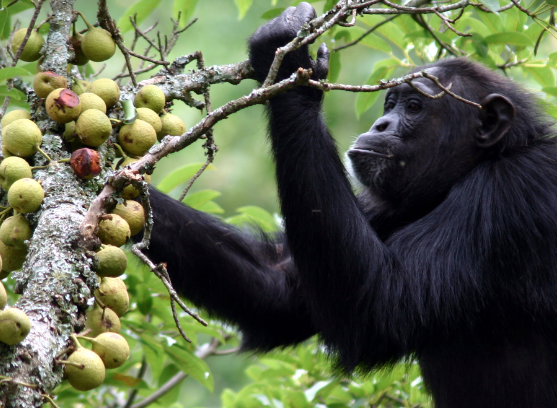Let’s explore what primates do in forests… For over 25 years, I have been documenting the incredibly important roles that monkeys and apes play in tropical forests through the simple act of feeding themselves. While most primates will consume insects and a bit of meat for fats and proteins, the vast majority of their foods come from plants. And, most primates prefer ripe fruit over just about everything else. Plants have their own goals: they need to ensure the survivorship of their offspring (seeds). As it turns out, the best place for this is some place far away from the parent plant. Almost all plants have some dispersal mechanism to get their seeds as far away as possible, whether through wind, water, or animals. In the tropics where I work, over 95% of tree species require animals to move their seeds! Other animals move seeds too – birds, bats, elephants, even ants – but, at my field site (Kibale, Uganda) and elsewhere in Africa, primates are particularly important: they are large, eat a lot of fruit, and move seeds (either through their poop or by spitting the seeds out) just the right distance for germination. In a single day, in just one square kilometer, the monkey species and chimpanzees I have studied can move over 40,000 large seeds and literally 100s of thousands of small seeds! Not only do they move more seeds and contribute more to forest regeneration than other animals (such as birds), but there are implications beyond the forest boundary. Around the tropics, people use plants from the forest they live in or around. In Kibale National Park, Uganda, I have found that almost half of the primate-dispersed plant species are used by humans living near the park for medicine, timber, construction, or ritual practice. My students, colleagues, and I have found similar patterns in Ivory Coast and Nigeria as well.
Tragically, just as ecologists and primatologists are learning about these important effects, we are losing the key players. Around the tropics, primate populations are in decline. Almost 2/3rds of primate species are threatened in some way, and some teeter on the brink of extinction. Ninety-one percent, for example, of all lemur species – found only on Madagascar – are either Critically Endangered, Endangered, or Vulnerable, making this the most endangered mammal group on the planet. There are many complex reasons for these declines associated with logging, hunting, a devastating commercial bush-meat market, disease, and the pet trade. As a consequence, forests are changing: we are left with “empty forests” that are no longer regenerating as they have for millions of years. In the absence of dispersers such as primates, seeds languish under their parents and die. Genetic diversity of plant populations declines, and total species richness goes down. Forests, the resources within them, and community health decline too. Humans needs forests and forests need primates.

